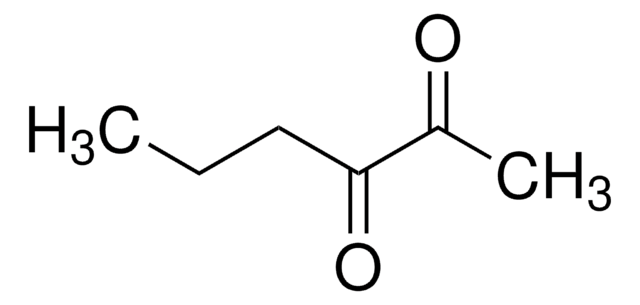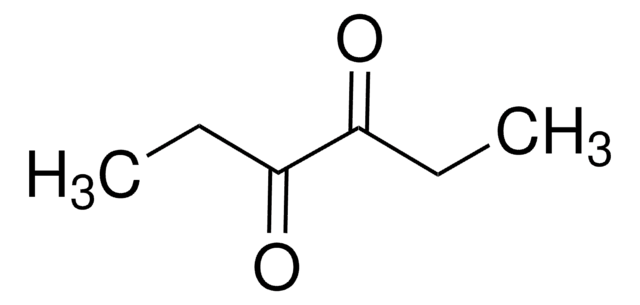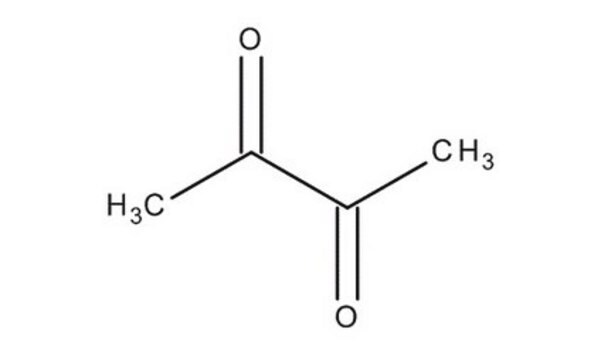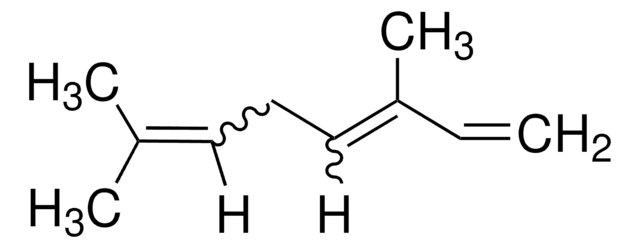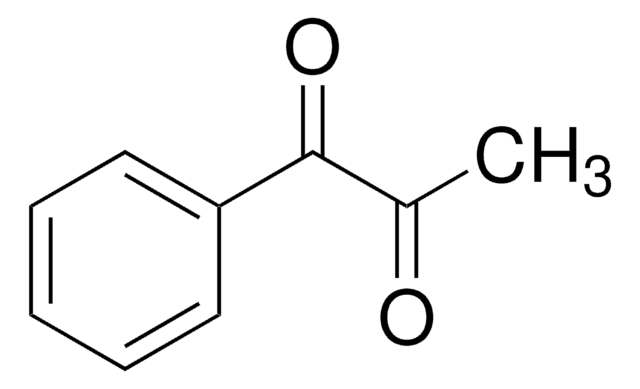W255801
2,3-Hexanedione
natural, 96%, FG
Sinonimo/i:
Acetyl butyryl
About This Item
Prodotti consigliati
Grado
FG
Fragrance grade
Halal
Kosher
natural
Livello qualitativo
agenzia
follows IFRA guidelines
Conformità normativa
EU Regulation 1223/2009
EU Regulation 1334/2008 & 178/2002
FDA 21 CFR 117
Densità del vapore
3.9 (vs air)
Tensione di vapore
10 mmHg ( 20 °C)
Saggio
96%
Caratteristiche più verdi
Less Hazardous Chemical Syntheses
Use of Renewable Feedstocks
Learn more about the Principles of Green Chemistry.
Indice di rifrazione
n20/D 1.412 (lit.)
P. ebollizione
128 °C (lit.)
Solubilità
H2O: soluble (slightly soluble)
alcohol: soluble (soluble)
oil: soluble (soluble)
propylene glycol: soluble (soluble)
Densità
0.934 g/mL at 25 °C (lit.)
applicazioni
flavors and fragrances
Documentazione
see Safety & Documentation for available documents
Allergene alimentare
no known allergens
Allergene in fragranze
no known allergens
Categoria alternativa più verde
Organolettico
butter; caramel; creamy; sweet
Temperatura di conservazione
2-8°C
Stringa SMILE
CCCC(=O)C(C)=O
InChI
1S/C6H10O2/c1-3-4-6(8)5(2)7/h3-4H2,1-2H3
MWVFCEVNXHTDNF-UHFFFAOYSA-N
Cerchi prodotti simili? Visita Guida al confronto tra prodotti
Categorie correlate
Descrizione generale
Applicazioni
- Volatile organic compounds of the soil bacterium Bacillus halotolerans suppress pathogens and elicit defense-responsive genes in plants.: This study explores the role of volatile organic compounds, including 2,3-Hexanedione, produced by Bacillus halotolerans. It demonstrates how these compounds suppress pathogenic microbes and induce defense genes in plants, suggesting potential applications in biocontrol and agriculture (Rana et al., 2024).
Avvertenze
Warning
Indicazioni di pericolo
Consigli di prudenza
Classi di pericolo
Flam. Liq. 3 - STOT RE 2 Inhalation
Organi bersaglio
Respiratory system
Codice della classe di stoccaggio
3 - Flammable liquids
Classe di pericolosità dell'acqua (WGK)
WGK 2
Punto d’infiammabilità (°F)
82.4 °F - closed cup
Punto d’infiammabilità (°C)
28 °C - closed cup
Scegli una delle versioni più recenti:
Possiedi già questo prodotto?
I documenti relativi ai prodotti acquistati recentemente sono disponibili nell’Archivio dei documenti.
I clienti hanno visto anche
Protocolli
-Cymene; 2,5-Dimethylpyrrole; Acetoin, ≥96%, FCC, FG; 2,5-Dimethylpyrazine; 2,6-Dimethylpyrazine; 2-Ethylpyrazine, ≥98%, FG; 2,3-Dimethylpyrazine; 4-Heptanone; 3-Ethylpyridine; 2,3,5-Trimethylpyrazine; Furfural; Pyrrole; Furfuryl acetate; Linalool; Linalyl acetate; 5-Methylfurfural; γ-Butyrolactone; 2-Acetyl-1-methylpyrrole; Furfuryl alcohol; 2-Acetylpyrrole; Pyrrole-2-carboxaldehyde
Global Trade Item Number
| SKU | GTIN |
|---|---|
| W255801-1KG-K | 4061838093349 |
| W255801-100G-K | 4061834404408 |
| W255801-500G-K | |
| W255801-SAMPLE-K | 4061834355397 |
Il team dei nostri ricercatori vanta grande esperienza in tutte le aree della ricerca quali Life Science, scienza dei materiali, sintesi chimica, cromatografia, discipline analitiche, ecc..
Contatta l'Assistenza Tecnica.